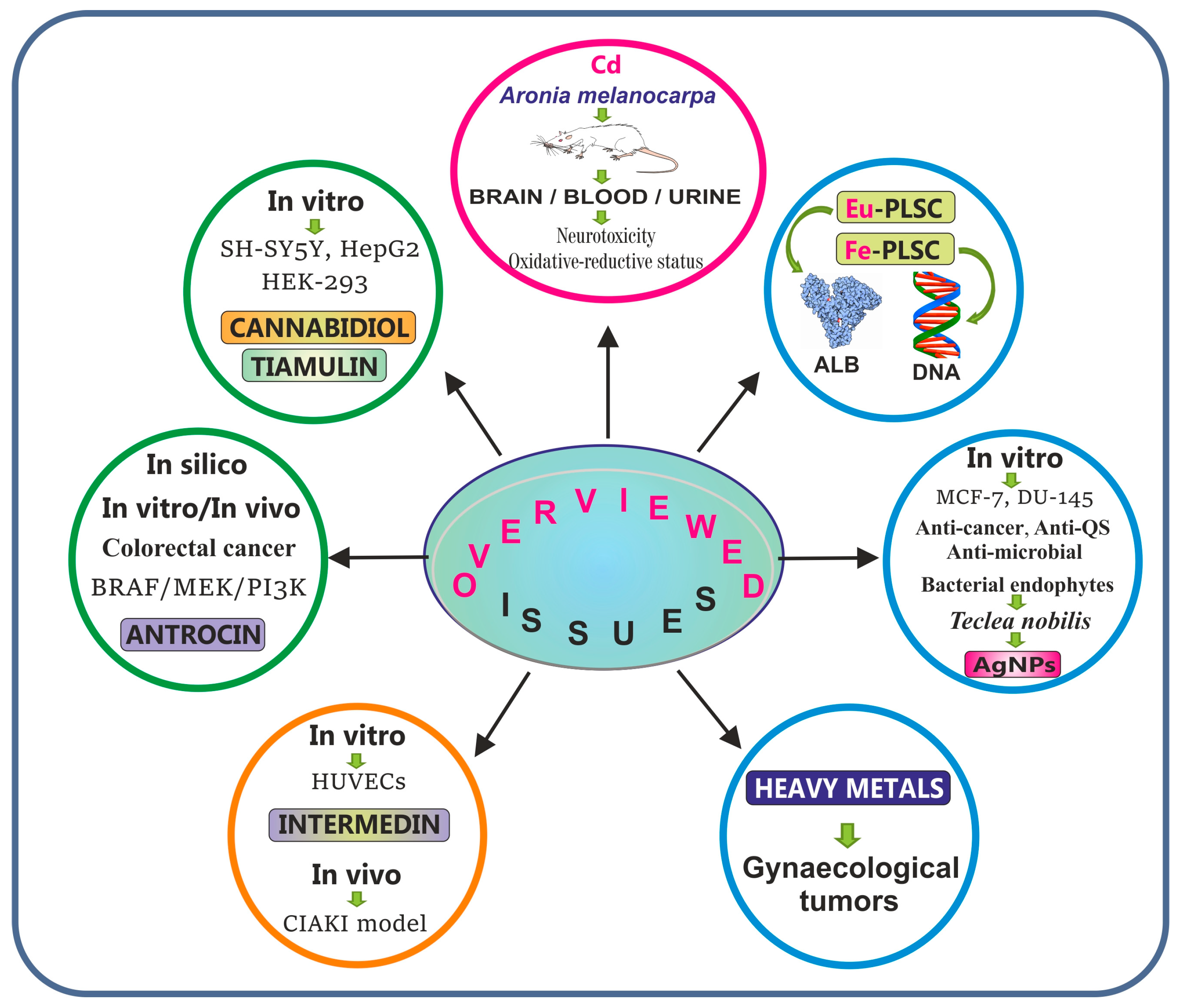Special Issue “Medical Value of Metal Complexes and Plant-Derived Compounds: Biological Evaluation, Health Effects, Challenges, and Future Opportunities”
1. Introduction and Scope
2. Contributions
2.1. Metals and Plant-Derived Compounds
2.2. Metals and Metal Complexes
2.3. Plant-Derived Compounds
2.4. Other Studies
3. Conclusions and Outlook
Author Contributions
Funding
Conflicts of Interest
List of Contributions
- Ruczaj, A.; Rogalska, J.; Gałażyn-Sidorczuk, M.; Brzóska, M.M. The protective effect of the supplementation with an extract from Aronia melanocarpa L. berries against cadmium-induced changes of chosen biomarkers of neurotoxicity in the brain–A study in a rat model of current liftime human exposure to this toxic heavy metal. Int. J. Mol. Sci. 2024, 25, 10887. https://doi.org/10.3390/ijms252010887.
- Mohamed, F.; Chenia, H.Y. Antimicrobial, anti-quorum sensing, and anti-cancer potential of silver nanoparticles synthesized from two Kenyan bacterial endophytes isolated from Teclea nobilis. Int. J. Mol. Sci. 2025, 26, 3306. https://doi.org/10.3390/ijms26073306.
- Jevtovic, V.; Perendija, S.; Alrashidi, A.A.; Alreshidi, M.A.; Alzahrani, E.A.; Alshammari, O.A.O.; Hussien, M.A.; Dimitrić Marković, J.; Dimić, D. Structural, computational, and biomoleclular interaction study of europium(III) and iron(III) complexes with pyridoxal-semicarbazone ligand. Int. J. Mol. Sci. 2025, 26, 5289. https://doi.org/10.3390/ijms26115289.
- Kozak, J. The role of heavy metals in the biology of gynaecological neoplasm. Int. J. Mol. Sci. 2025, 26, 5155; https://doi.org/10.3390/ijms26115155.
- Pankowska, E.; Kończak, O.; Żakowicz, P.; Wojciechowicz, T.; Gogulski, M.; Radko, L. Protective action of cannabidiol on tiamulin toxicity in humans – In vitro study. Int. J. Mol. Sci. 2024, 25, 13542. https://doi.org/10.3390/ijms252413542.
- Chen, J.S.; Enwolo-Chibueze, C.G.; Chinyama, H.A.; Lai, C.T.; Ezeala, I.C.; Huang, P.Y.; Wu, A.T.H.; Huang, Y.J. Integrated in silico and experimental validation of antrocin as a plant-derived multi-target therapeutic for BRAF/MEK/PI3K-driven colorectal cancer. Int. J. Mol. Sci. 2025, 26, 8780. https://doi.org/10.3390/ijms26188780.
- Gao, T.; Gu, R.; Wang, H.; Li, L., Zhang, B.; Hu, J.; Tian, Q.; Chang, R.; Zhang, R.; Zheng, G.; Dong, H. The protective role of intermedin in contrast-induced acute kidney injury: Enhancing peritubular capillary endothelial cell adhesion and integrity through the cAMP/Rac1 pathway. Int. J. Mol. Sci. 2024, 25, 11110. https://doi.org/10.3390/ijms252011110.
References
- Chaachouay, N.; Zidane, L. Plant-derived natural products: A source for drug discovery and development. Drugs Drug Candidates 2024, 3, 184–207. [Google Scholar] [CrossRef]
- Gielecińska, A.; Kciuk, M.; Mujwar, S.; Celik, I.; Kołat, D.; Kałuzińska-Kołat, Ż.; Kontek, R. Substances of natural origin in medicine: Plants vs. cancer. Cells 2023, 12, 986. [Google Scholar] [CrossRef] [PubMed]
- Thomford, N.E.; Senthebane, D.A.; Rowe, A.; Munro, D.; Seele, P.; Maroyi, A.; Dzobo, K. Natural products for drug discovery in the 21st century: Inovations for novel drug discovery. Int. J. Mol. Sci. 2018, 19, 1578. [Google Scholar] [CrossRef] [PubMed]
- Sobral, A.F.; Cunha, A.; Costa, I.; Silva-Carvalho, M.; Silva, R.; Barbosa, D.J. Environmental xenobiotics and epigenetic modifications: Implications for human health and disease. J. Xenobiot. 2025, 15, 118. [Google Scholar] [CrossRef]
- Fraqueza, G.; Batista de Carvalho, L.A.E.; Marques, M.P.M.; Maia, L.; Ohlin, C.A.; Casey, W.H.; Aureliano, M. Decavanadate, decaniobate, tungstate and molybdate interactions with sarcoplasmic reticulum Ca2+-ATPase: Quercetin prevents cysteine oxidation by vanadate but does not reverse ATPase inhibition. Dalton Trans. 2012, 41, 12749–12758. [Google Scholar] [CrossRef] [PubMed]
- Lopez-Sanchez, C.; Lagoa, R.; Poejo, J.; Garcia-Lopez, V.; Garcia-Martinez, V.; Gutierrez-Merino, C. An update of kaempferol protection against brain damage induced by ischemia-reperfusion and by 3-nitropropionic acid. Molecules 2024, 29, 776. [Google Scholar] [CrossRef] [PubMed]
- Brzóska, M.M.; Gałażyn-Sidorczuk, M.; Rogalska, J. The Preventive impact of chokeberry (Aronia melanocarpa L.) extract regarding the disruption of calcium and phosphorus homeostasis and chosen pathways of its regulation in an animal model of general population exposure to cadmium. Nutrients 2025, 17, 702. [Google Scholar] [CrossRef] [PubMed]
- Rambaran, N.; Naidoo, Y.; Mohamed, F.; Chenia, H.Y.; Baijnath, H. Antibacterial and anti-quorum sensing properties of silver nanoparticles phytosynthesized using Embelia ruminata. Plants 2024, 13, 168. [Google Scholar] [CrossRef] [PubMed]
- Avdović, E.; Dimić, D.; Nakarada, Đ.; Simijonović, D.; Jovičić Milić, S.; Marković, K.; Grujović, M.; Antonijević, M.; Ćirić, A.; Milenković, D.; et al. Evaluation of bioactive properties of ultrasound-assisted extracts from prokupac grape skins for functional foods. Antioxidants 2025, 14, 733. [Google Scholar] [CrossRef] [PubMed]
- Kuć-Szymanek, A.; Kubik-Machura, D.; Kościelecka, K.; Męcik-Kronenberg, T.; Radko, L. Neurotoxicological effects of some mycotoxins on humans health and methods of neuroprotection. Toxins 2025, 17, 24. [Google Scholar] [CrossRef] [PubMed]

Disclaimer/Publisher’s Note: The statements, opinions and data contained in all publications are solely those of the individual author(s) and contributor(s) and not of MDPI and/or the editor(s). MDPI and/or the editor(s) disclaim responsibility for any injury to people or property resulting from any ideas, methods, instructions or products referred to in the content. |
© 2025 by the authors. Licensee MDPI, Basel, Switzerland. This article is an open access article distributed under the terms and conditions of the Creative Commons Attribution (CC BY) license (https://creativecommons.org/licenses/by/4.0/).
Share and Cite
Ścibior, A.; Aureliano, M.; Llopis, J. Special Issue “Medical Value of Metal Complexes and Plant-Derived Compounds: Biological Evaluation, Health Effects, Challenges, and Future Opportunities”. Int. J. Mol. Sci. 2025, 26, 9678. https://doi.org/10.3390/ijms26199678
Ścibior A, Aureliano M, Llopis J. Special Issue “Medical Value of Metal Complexes and Plant-Derived Compounds: Biological Evaluation, Health Effects, Challenges, and Future Opportunities”. International Journal of Molecular Sciences. 2025; 26(19):9678. https://doi.org/10.3390/ijms26199678
Chicago/Turabian StyleŚcibior, Agnieszka, Manuel Aureliano, and Juan Llopis. 2025. "Special Issue “Medical Value of Metal Complexes and Plant-Derived Compounds: Biological Evaluation, Health Effects, Challenges, and Future Opportunities”" International Journal of Molecular Sciences 26, no. 19: 9678. https://doi.org/10.3390/ijms26199678
APA StyleŚcibior, A., Aureliano, M., & Llopis, J. (2025). Special Issue “Medical Value of Metal Complexes and Plant-Derived Compounds: Biological Evaluation, Health Effects, Challenges, and Future Opportunities”. International Journal of Molecular Sciences, 26(19), 9678. https://doi.org/10.3390/ijms26199678






